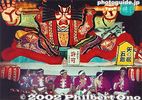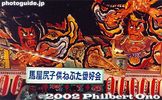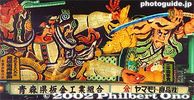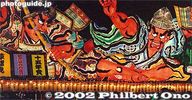 Image search results - "nebuta" Image search results - "nebuta" |

Nebuta are giant, wire-frame, paper lanterns shaped in various legendary and macho characters.The Aomori Nebuta Matsuri is held in Aomori City in Aomori Prefecture during Aug. 2-7. Nebuta are giant, wire-frame, paper lanterns shaped in various legendary and macho characters such as samurai warriors, demons, and gods. They are fantastic works of art dramatically illuminated from the inside. The floats are paraded along the main streets of the city near Aomori Station every night of the festival.
From August 2 to 6, the Nebuta parade is held from 7 p.m. to 9 p.m. On the 2nd and 3rd, the parade is geared for the many children who participate by pulling the floats. About 15 large Nebuta floats and some small Nebuta floats for the children are paraded.
The festival's peak period is from the 4th to the 6th when over 20 large Nebuta floats make their rounds. Be sure to see the festival on one of these three nights.
On the 7th, the last day, the parade is in the afternoon from 1 p.m. to 2:30 p.m. Later in the evening, the Nebuta floats are put on boats to be highlighted by a fireworks display.
The festival is designated by the government as an Important Intangible Folk Culture Asset and not to be missed if you have the chance. It's well worth the trip up north.
|
|

The Nebuta floats are judged in a contest and various awards are given.The Nebuta floats are beautiful objects of light. They are swung left and right and all around. The crowd applaud whenever the Nebuta faces them directly. The sculpture's lights inside are powered by a noisy generator on wheels under the float. The parade progresses quickly and the splendid Nebuta figures pass by one after another. You have to be there in person to feel the power and presence of the giant Nebuta. They represent the very soul and spirit of men. It's enough to give you goose bumps.
The Nebuta floats are judged in a contest and various awards are given. The best ones are preserved at the Nebuta-no-Sato (Nebuta Village) after the festival.
|
|

According to one story, the Nebuta has its roots in the 8th century.According to one story, the Nebuta has its roots in the 8th century when there was a rebellion in Ezo (Hokkaido). Ordered by Emperor Kanmu to quell the rebellion, generalissmo Sakanoue no Tamuramaro went to Ezo. However, he failed to capture the elusive chief of Ezo who went into hiding in the mountains.
Sakanoue then set up a trap with large votive lanterns which were lit and accompanied by taiko drums and flutes. This lured the curious Ezo chief out of hiding and led to his capture. The large lanterns were the forerunner of the Nebuta.
|
|

The first Nebuta was a large paper lantern made in 1593.According to historical records, the first Nebuta was a large paper lantern made in 1593 by Lord Tamenobu of Tsugaru (now part of Aomori) for the Bon festival in Kyoto. The Nebuta Festival itself started in the late 17th century.
|
|

Preparation for building a Nebuta sculpture starts right after the preceding Nebuta Festival.Preparation for building a Nebuta sculpture starts right after the preceding Nebuta Festival. During fall and winter, Nebuta artists conceive the ideas for the next year's Nebuta floats. The Nebuta figures depict some scene from kabuki or Japanese/Chinese history or legend. Once a theme is chosen, a sketch or design is made and presented to the sponsor (usually a company). Upon approval, actual construction begins.
During February and March, the smaller parts of the Nebuta figure, such as the hands and fingers, are constructed at home with steel wiring.
In May, a tent village is put up. In each tent, full-scale construction of the Nebuta is executed until the end of June. Steel wiring and slender pieces of wood are used to build the frame and props.
After the skeleton of lumber and wire is completed, about 400 light bulbs and fluorescent lights are installed inside. The lights are strategically placed so that the shadow of the lumber pieces is not cast outward.
Then comes the tedious task of pasting washi paper on the wire frame. This is done by highly-skilled housewives who have been doing it for 10 to 20 years. About ten of them work on one Nebuta, taking about 10 days. Since they have to work dextrously in all sorts of contorted positions, it is not a popular job and fewer women are willing to do it.
The paper is cut to fit the exact segment (usually rectangular) on the wire frame. A toothbrush is used to apply glue on the wiring and the paper is pasted and cut. Extra care is taken when the figure's face is papered. About 2,500 sheets of 531 x 393 mm paper are consumed in the process.
|
|

There are fewer than 30 Nebuta artists in the world.The giant white figure is brought to life by a Nebuta artist who paints it all by himself. First, the figure's basic outlines are painted with black sumi ink. Liquid paraffin is then applied to prevent the ink from running. Then colored dyes are painted or sprayed. When it comes to the face, very special care is taken. If he makes a mistake on the face, the paper is torn away and new sheets are pasted on. The very last thing painted on the Nebuta are the eyeballs. They give the sculpture its soul.
The completed Nebuta is lifted from the ground by 50 people onto a 1.5-meter-high wheeled platform. An illumination test symbolizes the Nebuta's completion. To ensure easy movement on the street, the Nebuta float is restricted to a width of 9 meters and a height of 5 meters. The float also bears the name of the sponsoring company or organization. It costs 10 to 20 million yen to build and operate a large Nebuta float. Corporate sponsors think it's money well spent since the Nebuta makes a great advertising vehicle and enhances the corporate image.
Top Nebuta artists are given over 3 million yen to cover labor and materials costs. By the time all the bills are paid, the artist has less than one-third the amount as compensation. Obviously, Nebuta artists are grossly underpaid for their highly-appreciated work. It really is a labor of love, and not for the money.
There are fewer than 30 Nebuta artists in the world, and only three of them work as full-time Nebuta artists. Since there is no money in it, would-be Nebuta artists and apprentices are few. To make it worse, there are no governmental measures to help resolve the problem.
|
|

The Nebuta festival is a great visual spectacle as well as a sound delight.The Nebuta festival is a great visual spectacle as well as a sound delight. The resounding beat of the taiko drums and the shrill of the flutes give the festival its soul. These are placed at regular intervals throughout the parade. The taiko beat is simple and repetitive, yet powerful and infectious.
|
|

Distinctly-costumed dancers called haneto.Each Nebuta float is accompanied by thousands of distinctly-costumed dancers called haneto. The huge Nebuta overlook a sea of haneto out in front with their colorful flowered straw hats bobbing up and down. They jerk and jingle and hop all over the road while shouting "Rasse, Rasse, Rassera!" They twist and shout amid reverberating taiko drums and flutes.
Sometimes they form a small circle and dance in unison. Their costumes have little bells which often fall off. Little kids run and pick up the fallen bells on the road. It is a frenzied celebration. If you want to join in the fun, you have to rent or buy a haneto costume (for around ¥10,000).
|
|

The parade route is quite long, and it's crowded along the parade route near Aomori Station.The parade route is quite long, and it's crowded along the parade route near Aomori Station. If you want plenty of elbow room while viewing, go toward the end of the parade route where the crowd is sparse.
In recent years, the Nebuta Festival has seen disturbances caused by gate-crashing, young hoodlums. A large police force is put in place to prevent trouble.
|
|
|

Children's night at Aomori Nebuta MatsuriOn the 2nd and 3rd, the parade is mainly for children who participate by pulling the floats. About 15 large Nebuta floats and some small Nebuta floats for the children are paraded.
|
|

Some female haneto taking a break after the festival.
|
|
|
|

Nebuta Danchi village where the floats are stored during the day.During the day, the Nebuta floats are housed in a tent village (Nebuta Danchi) open to the public. Each Nebuta has its own giant, green tent. These are the same tents used when the Nebuta were constructed.
|
|

Many children come and sit in front of the Nebuta to sketch it.
|
|
|

This young girl was quite a talented artist who drew the attention of the other kids.
|
|

Perhaps she might be able to help paint (or build) the real thing someday.
|
|

In Oshimizu Park were these nebuta tents where they store the nebuta floats. 大清水公演
|
|

The nebuta tents were built in late July. No kids around sketching the nebuta though, as they do in Aomori during the day.
|
|

Inside the nebuta tent was this nebuta float from Aomori, arrived earlier in Aug.
|
|
|

Patching up the damaged parts of the float. Apparently, it got damaged as it passed under a bridge that is a little too low for the giant nebuta.
|
|
|
|
|

Another giant nebuta float.
|
|
|
|

Monkey's underarm has patch-up work.
|
|

A third giant nebuta depicts the Pharaoh Ramses II. Seeing an Egyptian theme on a Japanese float was interesting.
|
|

The fourth giant nebuta was perhaps the most unique. It was made of inflatable vinyl. It is partially deflated here.
|
|

Inside the nebuta tent.
|
|
|
|

From about 4 pm, they had the Matsuri Parade on the main road. まつりパレード 万博山車パレード
|
|
|

万博山車パレード
|
|

Then came this giant mikoshi portable shrine called the Tsukuba Manto Mikoshi. It doesn't seem to belong to any shrine. つくば万灯神輿
|
|
|

The mikoshi goes to meet the float.
|
|

Banpaku Float
|
|
|
|

At 5 pm, the Nebuta Parade started. It was kind of strange to see a nebuta parade in almost broad daylight.
|
|

The floats were covered with plastic due to drizzling rain.
|
|

The first big one squeezes under the bridge.
|
|
|
|

Haneto dancers. Much fewer of them than in Aomori.
|
|

At first glance, it looks very strange. But they soon inflated it.
|
|

Being inflated now.
|
|

Another one squeezes through.
|
|
|

Almost fully inflated.
|
|
|

Haneto
|
|
|

This small float by local Boy Scouts.
|
|

This float by a junior high school.
|
|

The inflated nebuta comes around.
|
|

At first, I thought it looked kind of gimmicky, comical, and fake, but it turned out to be quite impressive.
|
|

The slayed dragon exhaled smoke.
|
|

Poor dragon
|
|

Quite dramatic indeed.
|
|
|

Too bad the plastic was on the floats.
|
|
|
|
|

Rear view.
|
|

Ramses II
|
|
|

At the very end, despite the rain, they took off the vinyl.
|
|

Rear view of Ramses II
|
|

Each giant nebuta float is preceded by a set of drums and drummers.
|
|

And other musicians.
|
|
|
|
|

Without the plastic covering.
|
|

Rear view has a sleeping cat.
|
|

Nebuta face-off.
|
|

For the finale, all the giant nebuta gathered at the large intersection. They didn't do much.
|
|

Haneto
|
|

Matsuri Tsukuba posters
|
|
|
|